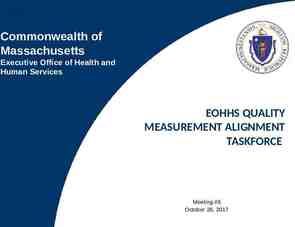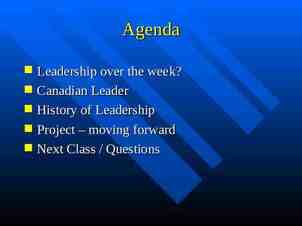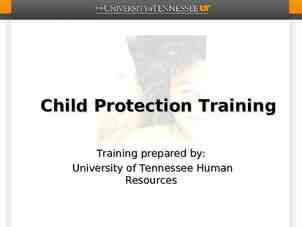4-1 FINANCIAL PLANNING AND CONTROL Sales forecasts Projected
27 Slides371.82 KB

4-1 FINANCIAL PLANNING AND CONTROL Sales forecasts Projected financial statements – Additional Funds Needed – Also called External Funds Needed (EFN) Financial control Hypothetical Data for Northwest Chemical Company

4-2 Financial Planning and Control Financial Planning The projection of sales, income, and assets based on alternative production and marketing strategies, as well as the determination of the resources needed to achieve these projections. Forecasting also is important for production planning and human resource planning. Financial Control The phase in which financial plans are implemented; control deals with the feedback and adjustment process required to ensure adherence to plans and modification of plans because of unforeseen changes.

Financial Planning: 4-3 Growth is a key theme behind financial forecasting. Remember that growth should not be the underlying goal of a corporation – creating shareholder value is the appropriate goal. In many cases, however, shareholder value creation is enabled through corporate growth. The sales forecast predicts a firm’s unit and dollar sales for some future period; generally based on recent sales trends plus forecasts of the economic prospects for the nation, region, industry, etc. We want to determine if we need external funds –

4-4 Percentage of Sales Method 1. 2. 3. 4. 5. 6. Projected Balance sheet forecasting of AFN Increased sales requires increased assets that must be financed. We will discuss the strategy for forecasting assets. Increased sales automatically increases spontaneous liabilities. Some financing will come from retained earnings. Depending on the information, we formulate a strategy for determining RE. If additional funds are needed we have to choose to finance with external funds -- debt or stock. #5 affects #4 -- thus, we sometimes use an iterative approach to refine the estimate.

4-5 Projected balance sheet A L OE on a balance sheet If A L OE both at the beginning and end of an accounting period – Then A L OE – Which is the fundamental basis for the sources and uses of funds statements – In other words the accounting works right The concern is about acquiring outside capital – Debt and Equity Bond issue or loans Stock Issue External sources take a lead time and planning

4-6 Steps to get AFN – simple one-pass forecast balance sheet method 1. 2. 3. 4. 5. Calculate RE with the data given (method varies) Increase CA and spontaneous liabilities proportionately with sales Increase FA if needed based on capacity information given Carry over bonds/bank-loans and stock Calculate TA - (TL E) AFN AFN additional funds needed from external sources

Hand out simple example 4-7

Two pass method example: Northwest Chemical: next year’s Sales Projection (millions of dollars) 3,000 2,500 2,000 1,500 1,000 500 0 1996 1997 1998 1999 2000 2001 4-8

4-9 Northwest Chemicals Oregon producer of Ag Chemicals Prepare financial forecast, main assumption is a 25% increase in sales Want to know how performance/ratios changes. One of the main items is Additional Funds Needed We will use the percentage of sales method of forecasting financial statements. This will give you a thorough feel for the process of forecasting financial statements.

4-10 North West Chemical: Key Ratios last year Profit Margin ROE DSO Inv. turnover F.A. turnover T.A. turnover Debt/ assets TIE Current ratio Payout ratio NWC 2.52% 7.20% 43.2 days 5.00x 4.00x 2.00x 30.00% 6.25x 2.50x 30.00% Industry 4.00% 15.60% 32.0 days 8.00x 5.00x 2.50x 36.00% 9.40x 3.00x 30.00% Condition Poor “ “ “ “ “ Good Poor “ O.K.

4-11 Projected Financial Statements Step 1. Forecast next year’s Income Statement to get Ret. Earn. Key Assumptions Sales are expected to increase by 500 million. (% S 25%). Sales factor 1.25 Operated at full capacity last year Use to increase fixed assets and Capacity factor 1.25 also fixed cost. Payables and accruals grow proportionally with sales. Dividend payout (30%) will be maintained. No new common stock will be issued. To finance AFN half notes and half long term debt will be used Interest rate 8% for any debt.

4-12 NWC: Projected Income Statement: Sales Less: VC FC EBIT Interest EBT Taxes (40%) Net. income Div. (30%) Add. to RE Last Yr. 2,000 1,200 700 100 16 84 34 50 15 35 Factor x1.25 x1.25 x1.25 Initial Forecast 2,500 1,500 875 125 16 109 44 65 19 46

4-13 Projected Financial Statements Step 2. Forecast the Balance Sheet Last Yr Factor Initial Forecast Cash/sec. 20 x1.25 25 Accts. rec. 240 x1.25 300 Inventories 240 x1.25 300 Total CA 500 Net FA Total assets 500 625 x1.25 1,000 At full capacity, so all assets must increase in proportion to sales. 625 1,250

4-14 Projected Financial Statements Step 2. Forecast the 2001 Balance Sheet (Liability & Equity) AP/accruals Notes payable Total CL L-T debt Common stk. Ret. earnings Total liab./eq. 2000 100 100 200 100 500 200 1,000 Factor x1.25 46* Initial Forecast 125 100 225 100 500 246 1,071 *From projected income statement.

4-15 Projected Financial Statements Step 3. Raising the Additional Funds Needed Forecasted total assets 1,250 Forecasted financing 1,071 Forecast AFN1 179 NWC must have the assets to make forecasted sales. The balance sheet must balance. So, we must raise 179 externally.

4-16 How will the AFN be financed? Additional notes payable 0.5 ( 179) 89.50 Additional L-T debt 0.5 ( 179) 89.50 But this financing will add 0.08 ( 179) 14.32 to interest expense, which will reduce NI and retained earnings.

4-17 Projected Financial Statements Step 4. Financing Feedbacks The effects on the income statement and balance sheet of actions taken to finance forecasted increases in assets.

4-18 NWC: Revised Forecast of Income Statement 1st Pass Feedback 2nd Pass Sales Less: VC FC EBIT Interest EBT Taxes (40%) Net. income Div. (30%) Add. to RE 2,500 1,500 875 125 16 109 44 65 19 46 14 2,500 1,500 875 125 30 95 38 57 17 40

4-19 NWC: Revised Forecast of Balance Sheet (Assets) 1st Pass Feedback 2nd Pass Cash/sec. 25 25 Accts. rec. 300 300 Inventories 300 300 Total CA 625 625 625 625 1,250 1,250 Net FA Total assets No change in asset requirements.

4-20 NWC: Feedback on the Forecast of the Balance Sheet (Liabilities & Equity) AP/accruals Notes payable Total CL L-T debt Common stk. Ret. earnings Total liab./eq. 1st Pass Feedback 2nd Pass 125 125 100 89.5 190 225 100 500 246 1,071 89.5 -6 315 189 500 240 1,244 Look at a spreadsheet with all of this on one page.

4-21 Results of the Adjusted Forecast: Forecasted assets 1,250 (no change) Forecasted claims 1,244 (higher) 2nd pass AFN 6 (short) Cumulative AFN 179 6 185. The 6 shortfall came from reduced net earnings. Additional passes could be made until assets exactly equal liabilities/equity. ex: 6 (0.08) 0.48 interest 3rd pass.

4-22 North West Chemical: Adjusted Key Ratios Profit Margin ROE DSO (days) Inv. turnover F.A. turnover T.A. turnover D/A ratio TIE Current ratio Payout ratio NWC Last Yr. Est. Next 2.52% 2.27% 7.20% 7.68% 43.2 43.2 5.00x 5.00x 4.00x 4.00x 2.00x 2.00x 30.00% 40.34% 6.25x 4.12% 2.50x 1.99x 30.00% 30.00% Industry 4.00% 15.60% 32.0 11.00x 5.00x 2.50x 36.00% 9.40x 3.00x 30.00% Poor “ “ “ “ “ “ “ “ O.K.

4-23 Analysis of the Forecast: How does North West Chemical Compare? Not very profitable relative to other companies in the industry. Carrying excess inventory and receivables. Debt ratio projected to move ahead of average. Overall, not in good shape and doesn’t appear to be improving.

4-24 Other Considerations in Forecasting: Excess Capacity Suppose last year fixed assets had been operated at 90% of capacity: 1.25 x .90 1.125; will be at 112.5% of capacity Increase fixed assets and fixed cost by 12.5% (example in spreadsheet) Suppose last year fixed assets had been operated at only 75% of capacity: 1.25 x .75 .9375; will be at 93.75% of capacity Would keep fixed assets and fixed cost the same as last year.

4-25 How would excess capacity affect the forecasted ratios? Sales wouldn’t change but assets would be lower, so turnovers would be better. Less new debt, hence lower interest, so higher profits, EPS,ROE. Debt ratio, TIE would improve.

4-26 Forecasted Ratios: Profit Margin ROE DSO (days) Inv. turnover F.A. turnover T.A. turnover D/A ratio TIE Current ratio Payout ratio % of Capacity last year 100% 90% 2.28% 4.56% 7.70% 14.6% 43.2 43.2 5.00x 5.00x 4.00x 4.44x 2.00x 2.10x 40.8% 34% 4.17% 9.48x 1.96x 2.35x 30.00% 30.00% Industry 4.00% 15.60% 32.0 8.00x 5.00x 2.50x 36.00% 9.40x 3.00x 30.00%

4-27 Summary: How different factors affect the AFN forecast. Dividend payout ratio changes. If reduced, more RE, reduce AFN. Profit margin changes. If increases, total and retained earnings increase, reduce AFN. Plant capacity changes. Less capacity used, less need for AFN. AP Payment terms increased to 60 days from 30. Accts. payable would double, increasing liabilities, reduce AFN.






